At-Risk Education Tools
> Ereiser
At-risk
education
Challenging Learning. James Nottingham created the Learning Pit®.
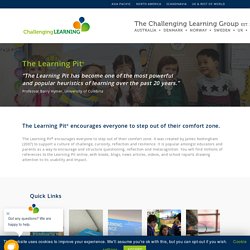
His inspiration had two main sources (though in truth, probably dozens of sources – as is the way with creativity). The first was his experience of Philosophy for Children (P4C) as a way to teach young people how to learn as much as what to learn.
James Nottingham's Learning Challenge (Learning Pit) animation. Classroom Strategies. Understanding Differentiated Instruction Summer DI Readings List: 150+ Seedlings for Growing Stronger Learners: Browse a bountiful reading list as you plan your garden of differentiated-instruction methods and strategies for the year. (Edutopia, 2015) Myth-Busting Differentiated Instruction: 3 Myths and 3 Truths: Get to the bottom of common misconceptions about differentiated instruction. For a quick reference on what differentiated is -- and what it isn't -- Differentiation Is / Differentiation Is Not, a set of infographics from ASCD, is also worth checking out.
The Developmental Assets Framework. Download a printable version of the Developmental Assets® Framework Download printable PDF versions of the Developmental Assets Framwork, available in English, Spanish and broken down by age-specific adaptations.
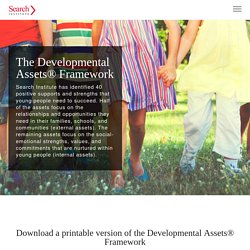
Also available are independent translations of the Developmental Assets Framework, created by local community groups for use with the children, youth, and families they serve. These are available in Acholi, Arabic, Armenian, Bulgarian, Chinese, Farsi, French, Hmong, Japanese, Khmer, Nuer, Russian, Somali, Urdu and Vietnamese.
Activities to Promote Parent Involvement. Research shows that children are more likely to succeed academically and are less likely to engage in violent behavior if their families are involved in their education.
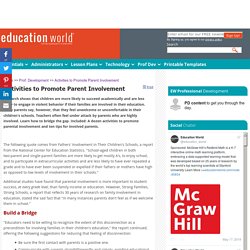
Many parents say, however, that they feel unwelcome or uncomfortable in their children's schools. Teachers often feel under attack by parents who are highly involved. Learn how to bridge the gap. Included: A dozen activities to promote parental involvement and ten tips for involved parents. The following quote comes from Fathers' Involvement in Their Children's Schools, a report from the National Center for Education Statistics. Additional studies have found that parental involvement is more important to student success, at every grade level, than family income or education.
Healing the Shame that Blinds, Binds and Grinds You. Helping Struggling Learners and Tools for Differentiation. Diigo Review for Teachers. 16 OER Sites Every Educator Should Know.
Open Educational Resources | Feature 16 OER Sites Every Educator Should Know By Dian Schaffhauser07/02/14 Open educational resources not only save students from triple-digit (or more!)
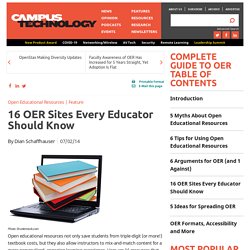
Textbook costs, but they also allow instructors to mix-and-match content for a more personalized, engaging learning experience. Here are 16 resources that offer a wide range of content and tools to help implement OER in just about any course.
SELearn Educator Portal. We know that materials matter. Mounting evidence suggests that providing teachers with access to high-quality, standards-aligned instructional materials and curriculum-based professional learning can result in improvement in student outcomes, making this a research-based school improvement strategy. More about this research here. For a detailed overview of high-quality instructional materials and professional learning, along with tools to see if your materials are aligned to standards, visit the new Instructional Materials and Professional Learning page.
WISELearn provides a centralized location for connecting Wisconsin educators and sharing classroom and professional learning resources.
OER Commons. Open Educational Resources (OER): Resource Roundup. OER, a part of the global open content movement, are shared teaching, learning, and research resources available under legally recognized open licenses -- free for people to reuse, revise, remix, and redistribute.
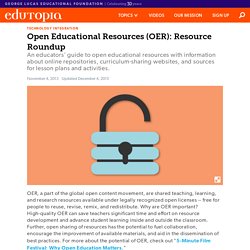
Why are OER important? High-quality OER can save teachers significant time and effort on resource development and advance student learning inside and outside the classroom. Further, open sharing of resources has the potential to fuel collaboration, encourage the improvement of available materials, and aid in the dissemination of best practices.
Digital Literacy - Critical Classroom Elements. (8) Pinterest.
Module from RDG Marian Unversity: Personal resource, digital literacy and overall education tool – ereiser
The Caring Educator. The Psychology of Self-Motivation. What kids wish their teachers knew. Reimagining Classrooms: Teachers as Learners and Students as Leaders. Future Outlook. Bullying in Academia. The Every Student Succeeds Act: An ESSA Overview. Published: March 31, 2016 In this video, Education Week's Alyson Klein unpacks the details of the new law and what it means for schools, educators, and students.
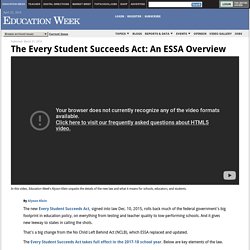
The new Every Student Succeeds Act, signed into law Dec. 10, 2015, rolls back much of the federal government's big footprint in education policy, on everything from testing and teacher quality to low-performing schools. And it gives new leeway to states in calling the shots. That's a big change from the No Child Left Behind Act (NCLB), which ESSA replaced and updated. The Every Student Succeeds Act takes full effect in the 2017-18 school year. Accountability Plans States still have to submit accountability plans to the Education Department.
What is 21st Century Education -youtube. Pinterest Board by Kate. (8) Pinterest. 4 Ways to Improve Digital Equity in Your Classroom. When we consider students' perspectives, small changes can have a big impact.
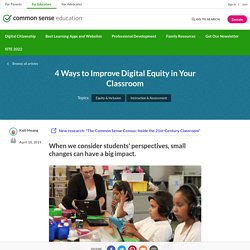
From Written to Digital: The New Literacy. Both the 21st-century economy and the careers needed to fuel it are changing at an unprecedented rate. Students must be prepared for nonlinear careers, pivoting to match the ever-changing work landscape. We thus need to rethink not just how we teach our students but what we teach our students. The people who were comfortable at this humanities-technology intersection helped to create the human-machine symbiosis that is at the core of this story. In his book about the history of the digital revolution, Walter Isaacson contends that the major innovations of the digital revolution—from the first general-purpose computer to the transistor to the iPhone—were all created by individuals who understood how to synthesize the humanities with technology.
18 Digital Tools and Strategies That Support Students' Reading and Writing.
Marissa Broyles taught English and social studies to a class or sixth graders who needed extra support last year. She experimented with many of the tools Levesque has compiled and saw how her willingness to be flexible as a teacher made her students feel supported. One girl with dyslexia could easily have been mistaken for being further behind than she really was because of how much she struggled with writing. “That was her only barrier, and it was so sad for me because she's one of the brightest students I've ever taught, but the dyslexia was really getting in her way," Broyles said. Broyles began allowing the student to use Screencastify, a Chrome extension that lets users record a video of what's happening on their screen while voicing an explanation.
The student would pull up a digital copy of a book, for example, find evidence to support her claims, and explain her thinking orally.
For teachers just starting out with educational technology, the task at hand can sometimes seem daunting.

Even though tools such as the SAMR model can help, the plethora of choices available can prove paralyzing, frequently resulting in ongoing substitutive uses of the technology that block, rather than enable, more ambitious transformative goals. The approach below is designed to help overcome this barrier, and is inspired in its form by Alexander’s notion of Design Patterns -- a clearly structured solution to a recurring design problem -- which has been applied to education scenarios by Bergin et al. While it is not laid out exactly as a design pattern would be, it nonetheless provides a framework that a teacher could use in similar fashion. The goal for the teacher is to construct a simple SAMR ladder that is coupled to Bloom’s Revised Taxonomy -- i.e., as the task moves from lower to upper levels of the taxonomy, it also moves from lower to upper levels of SAMR.
Best Resources Pinterest Board.
Mrs. K's Kids Resource Pinterest Page. Google Search Tricks for Research. 50 Activities To Promote Digital Media Literacy In Students. 50 Challenging Activities To Promote Digital Media Literacy In Students by Terry Heick Literacy is changing–not at its core necessarily, but certainly at its edges as it expands to include new kinds of “reading.”

Digital media is quickly replacing traditional media forms as those most accessible to most 21st century learners.
Helping Students Become Better Online Researchers. Your students are probably Internet authorities.
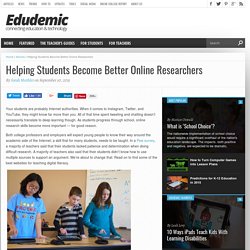
When it comes to Instagram, Twitter, and YouTube, they might know far more than you.
Course: RDG 674/LEC/ON01-2019/SPRING/SP2 - Digital Literacies. Chapter 7- Intelligence -Part 1. AnswerGarden » ...- Plant a Question, Grow Answers! Generate a live word cloud with your audience.
ARAE At-Risk and Alternative Education - Marian University - Accueil. How to Maximize the Impact of Email Newsletters With Content Curation. One of the best ways to build trust with your audience is by opening a two-way communication channel.
Tool for communicating with parent network – ereiser
Social media has provided this for a long time now. Everyone can now tweet, message, and tag brands through channels they hang out on. When you’re on the business side of this interaction, there’s a problem (and it’s not quite obvious): these platforms dictate the rules of your engagement with the users. Algorithms change and your reach drops, as it happened for many companies when Facebook introduced the algorithmic feed.
In fact, this change was so severe that for many Facebook Pages, their post reach dropped to only about 2% of their audience. Let’s not forget that some platforms simply stop existing, like Google+ did in April 2019. In other words, you can’t afford to be at the mercy of these platforms. The solution: curating a unique, engaging email newsletter that will position you as the go-to resource in your industry. The key word here is curating, rather than creating from scratch.
Storybird Review for Teachers. Comment motiver ses enfants. What makes a good teacher great?
Toxic Culture of Education: Joshua Katz at TEDxUniversityofAkron.
Alternative education. Creative and active teaching and learning: Dr. John Zubizarreta at TEDxColumbiaSC. Proofing a Question - BVSD - Google Drawings. How to use memory techniques to improve education. The Pedagogical Patterns Project. SAMR Model. Sketchnoting. Practical/Functional Learning & E-Safety. Which Digital Citizenship Skills Do Students Need Most?
How to identify common signs of suicide tendencies and ways to seek help. Life Skills Training for Individuals with Disabilities. Learning to Learn: You, Too, Can Rewire Your Brain. What if Schools Taught Us How to Learn. Learning styles & the importance of critical self-reflection. Collections & Campaigns. Dyslexia Awareness: In partnership with Made By Dyslexia. How to identify common signs of suicide tendencies and ways to seek help.
Learning. Critical Thinking: The Key to Digital Literacy – Fishtree. How should we define digital literacy?
Response: Reading Digitally vs. Reading Paper. ReadWorks Review for Teachers. ReadWorks is a free website offering resources for differentiated reading instruction, specifically comprehension.
Flocabulary Review for Teachers. Flocabulary is an online platform that delivers educational hip-hop songs, videos, and supplemental activities for kids in grades K-12.
BrainPOP Jr. Review for Teachers. MobyMax Review for Teachers. Introduction to the SAMR Model. Pre-writing - Inspired Writing. Digital Tools for Education. Understand what you read.










